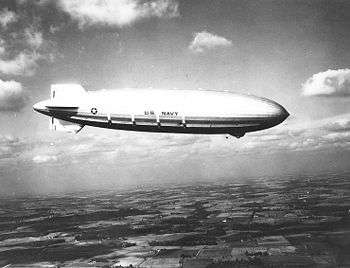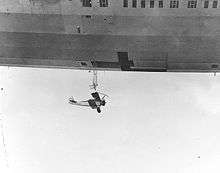Airborne aircraft carrier
An airborne aircraft carrier is a type of mother ship aircraft which can carry, launch, retrieve and support other smaller aircraft.[1]
The only examples to have been built were airships, although airborne aircraft carriers of various types appear in fiction, such as the helicarrier from Marvel Comics, the Valiant from series 3 of Doctor Who, and an unnamed one in Sky Captain and the World of Tomorrow.
Airship projects
In July 1917, experiments were made with aircraft slung under HM Airship No. 23, in hopes that they could defend the airship. First an unmanned, then a manned, Sopwith Camel fighters were launched successfully. The experiment was successfully completed with two other manned Camels.[2]
The British Imperial Airship Scheme of 1924 initially envisaged an airship that could carry five fighter aircraft in military use, but this requirement was abandoned and the project saw only the civilian R100 and R101 airships to completion.[3]
Akron-class


The two rigid airships of the Akron class, Akron and Macon, were built for scouting duties for the U.S. Navy and operational between 1931 and 1935.
Following experiments with launching and recovering small aeroplanes using USS Los Angeles, the U.S. Navy designed Akron and Macon with internal hangars able to house a number of Curtiss F9C Sparrowhawk biplane fighters. The fighters were launched and recovered using a "trapeze" mechanism.[4]
With lengths of 785 ft (239 m), Akron and Macon were among the largest flying objects in the world and still hold the world record for helium-filled airships. They were just 20 ft (6.1 m) shorter than the German hydrogen-filled airship Hindenburg.
Akron first flew on 8 August 1931 and Macon followed on 21 April 1933. The Sparrowhawk fighters became operational in September 1932. Akron was destroyed on 4 April 1933 [5] and Macon on 12 February 1935 [6]
During her accident-prone 18-month term of service, the Akron served as an airborne aircraft carrier for launching and recovering F9C Sparrowhawk fighter planes. Akron was destroyed[7] in a thunderstorm off the coast of New Jersey on the morning of 4 April 1933, killing 73 of her 76 crewmen and passengers. This accident was the largest loss of life for any airship crash.[8]
Macon was designed to carry biplane parasite aircraft, five single-seat Curtiss F9C Sparrowhawks for scouting or two-seat Fleet N2Y-1 for training. In service for less than two years, in 1935 Macon was damaged in a storm and lost off California's Big Sur coast, though most of the crew were saved. The wreckage is listed as "USS Macon Airship Remains" on the U.S. National Register of Historic Places.
Lockheed CL-1201
The Lockheed CL-1201 was a study for a giant atomic-powered transport aeroplane. Having a wing span of 1,120 feet (340 m), one variant studied was an airborne aircraft carrier with a complement of up to 22 fighter aircraft carried under its wings. [9]
Convair B-36 Peacemaker
The B-36 Peacemaker strategic bomber was at one point intended to function as an airborne aircraft carrier for up to four McDonnell F-85 Goblin parasite fighters [10]. Operational F-85-carrying B-36s were to have been capable of refueling and rearming their fighters in flight, while deploying and recovering them on a trapeze-like structure similar to that of the Akron and the Macon. No B-36 was ever equipped to carry the F-85, however, and the two prototypes only flew from a single modified B-29.
Boeing 747 Airborne Aircraft Carrier

In the early 1970s, Boeing conducted a study under a contract from the USAF for an airborne aircraft carrier for up to 10 Boeing Model 985-121 "microfighters", with the ability to launch, retrieve, re-arm, and refuel the microfighters. Boeing believed that the scheme would be able to deliver a flexible and fast carrier platform with global reach, particularly where other bases were not available. Modified versions of the 747-200 and Lockheed C-5A were considered as the base aircraft. The concept, which included a complementary 747 AWACS version with two reconnaissance "microfighters", was considered technically feasible in 1973.[11]
Lockheed C-130 Hercules
Since 2015, the United States Department of Defense has been investigating the prospect of deploying Dynamics X-61A Gremlin unmanned aerial vehicles from modified C-130 Hercules cargo aircraft. The plane will be able to deploy, support and recover drones [12][13] known as X-61A "Gremlins."[14] After completing their mission, the X-61A will deploy a parachute and be snatched out of the air by modified transport airplane.
See also
| Wikimedia Commons has media related to Airborne aircraft carriers. |
References
- Ege, L.; Balloons and airships, Blandford (1973), p. 204. "...ZRS-4 was a real aircraft carrier. It had been found feasible to attach an aeroplane to Los Angeles in flight and later release it again, but ZRS-4 could, while in flight, actually receive in flight five scout or reconnaissance aeroplanes and store them in a special hangar inside its huge belly."
- http://www.airshipsonline.com/airships/hma23/index.html
- Imperial Airship Service, The Airship Heritage Trust. Accessed 10 June 2009.
- "Plane Hitched To Dirigible by Hook in Flight" Popular Mechanics, August 1930
- Vaeth, J. Gordon; “U.S.S. Macon: Lost and Found”, National Geographic January 1992.
- Jones, L.S.; US Naval Fighters, Aero Publishers 1977.
- Commander Describes Akron Tragedy While Navy Search Goes On 1933/04/06 (1933). Universal Newsreel. 1933. Retrieved 22 February 2012.
- "10 Worst Airship Disasters in History". Retrieved 2013-03-03.
- "Archived copy". Archived from the original on 2016-03-01. Retrieved 2015-09-28.CS1 maint: archived copy as title (link)
- Gunston 1975, p. 483.
- "Investigation of a Micro-Fighter / Airborne Aircraft Carrier Concept" (PDF). Defense Technical Information Center. September 1973. Retrieved November 21, 2015.
- Mizokami, Kyle "DARPA wants to Turn Cargo Planes Into Flying Aircraft Carriers for Drones", Popular Mechanics, 19/12/17, accessed 25.02.2019
- "Flying Aircraft Carriers: US Plans to Release Drones from C-130", Forces Network, 03/01/18, accessed 25/02/2019
- "Gremlins Program Completes First Flight Test for X-61A Vehicle". www.darpa.mil. Retrieved 2020-01-31.
External links
![]()